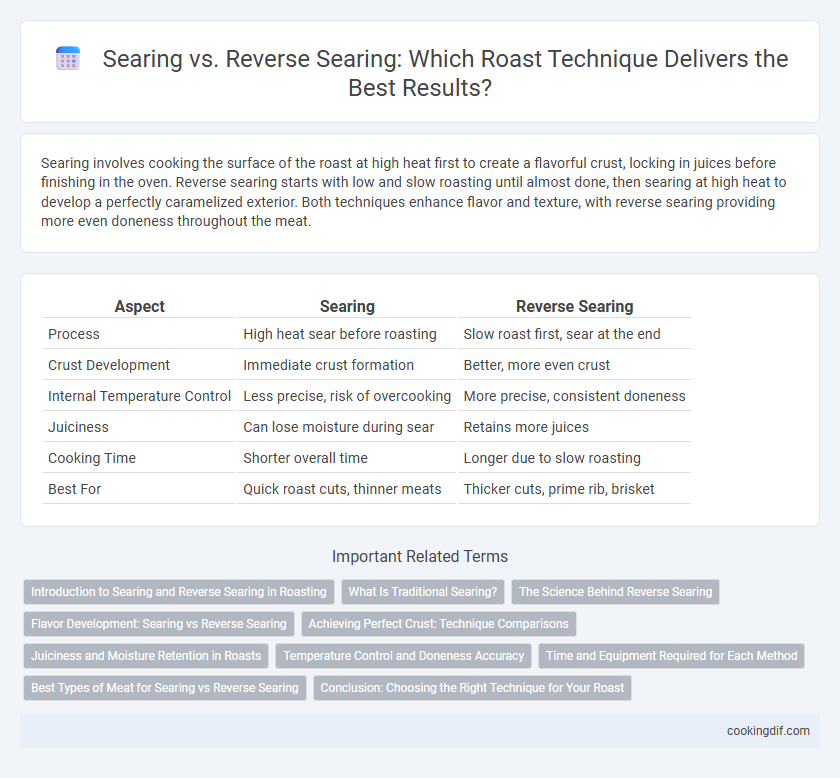Searing involves cooking the surface of the roast at high heat first to create a flavorful crust, locking in juices before finishing in the oven. Reverse searing starts with low and slow roasting until almost done, then searing at high heat to develop a perfectly caramelized exterior. Both techniques enhance flavor and texture, with reverse searing providing more even doneness throughout the meat.
Table of Comparison
| Aspect | Searing | Reverse Searing |
|---|---|---|
| Process | High heat sear before roasting | Slow roast first, sear at the end |
| Crust Development | Immediate crust formation | Better, more even crust |
| Internal Temperature Control | Less precise, risk of overcooking | More precise, consistent doneness |
| Juiciness | Can lose moisture during sear | Retains more juices |
| Cooking Time | Shorter overall time | Longer due to slow roasting |
| Best For | Quick roast cuts, thinner meats | Thicker cuts, prime rib, brisket |
Introduction to Searing and Reverse Searing in Roasting
Searing locks in the juices of a roast by quickly cooking the surface at high heat, creating a flavorful crust and enhancing Maillard reaction flavors. Reverse searing involves slowly cooking the roast at a low temperature first, then finishing with a high-heat sear to develop a caramelized outer layer while ensuring even internal doneness. Both methods optimize texture and flavor, with searing emphasizing crust formation upfront and reverse searing prioritizing precise temperature control and juiciness.
What Is Traditional Searing?
Traditional searing involves cooking the surface of a roast at high temperatures to create a flavorful, caramelized crust that locks in juices. This method typically starts with applying intense direct heat to the roast's exterior before finishing it in an oven or on a lower heat source. Searing enhances the roast's Maillard reaction, which develops complex flavors and an appealing brown color.
The Science Behind Reverse Searing
Reverse searing enhances roast flavor by slowly bringing the meat to an even internal temperature, allowing myoglobin to convert fully and resulting in better moisture retention. The low-and-slow approach promotes enzymatic breakdown of proteins, improving tenderness before a final high-heat sear creates a flavorful Maillard crust. This method contrasts traditional searing, which can cause uneven cooking and moisture loss due to immediate exposure to intense heat.
Flavor Development: Searing vs Reverse Searing
Searing creates a Maillard reaction on the roast's surface, developing intense caramelized flavors and a rich crust that enhances taste complexity. Reverse searing allows for even cooking throughout, preserving juiciness while still achieving a flavorful crust by finishing with high heat. Both techniques enhance flavor differently: searing prioritizes immediate crust development, while reverse searing balances tenderness and a subtle, savory exterior.
Achieving Perfect Crust: Technique Comparisons
Searing involves cooking the roast at high heat initially to quickly form a Maillard crust, locking in juices and enhancing flavor complexity. Reverse searing starts with low, slow roasting to evenly cook the interior, followed by high-heat searing to achieve a uniform, deeply caramelized crust. Both techniques optimize crust formation but differ in heat application timing, affecting texture and moisture retention.
Juiciness and Moisture Retention in Roasts
Searing creates a flavorful crust that helps lock in juices, but reverse searing enhances moisture retention by slowly cooking the roast at low temperatures first, allowing the meat to remain tender and evenly juicy. Reverse searing minimizes moisture loss by preventing the exterior from overcooking, resulting in a consistently juicy interior compared to traditional searing. Studies show reverse sear techniques reduce expelled meat juices by up to 30%, making it ideal for maintaining optimal roast juiciness.
Temperature Control and Doneness Accuracy
Searing involves cooking the roast at a high temperature initially to create a flavorful crust, while reverse searing starts with low heat and finishes with high heat for crust development. Reverse searing offers superior temperature control and doneness accuracy by allowing the internal temperature to rise gradually, reducing the risk of overcooking. This method ensures a consistent medium-rare center, making it ideal for precision-focused roasting.
Time and Equipment Required for Each Method
Searing requires less overall time, using high heat on a stovetop or grill to quickly brown the roast's exterior before finishing in the oven, typically needing only a cast iron skillet or grill and an oven. Reverse searing takes longer as the roast is slow-cooked at low temperature in the oven first, often several hours, before being quickly seared on a hot pan or grill. Equipment for reverse searing includes an oven with precise temperature control and a heavy skillet or grill for the final sear, emphasizing patience and controlled heat over speed.
Best Types of Meat for Searing vs Reverse Searing
Searing is ideal for tender cuts with a uniform thickness, such as ribeye, sirloin, and filet mignon, where high heat locks in juices and develops a flavorful crust. Reverse searing suits larger, thicker cuts like prime rib, brisket, and pork shoulder, as slow roasting ensures even cooking before a final high-heat sear enhances the exterior texture. Choosing the right roast technique depends on meat composition, with searing excelling in quick, intense heat applications and reverse searing benefiting cuts that require gentle, gradual cooking.
Conclusion: Choosing the Right Technique for Your Roast
Searing creates a flavorful crust quickly by applying high heat first, locking in juices, while reverse searing gently cooks the meat at low temperature before finishing with a high-heat sear for even doneness and tender texture. For thick cuts like prime rib or large roasts, reverse searing ensures uniform cooking and enhanced tenderness. Choose searing for faster cooking and a bold crust on thinner roasts, and reverse searing when precision and juiciness are paramount.
Searing vs reverse searing for roast technique Infographic

 cookingdif.com
cookingdif.com